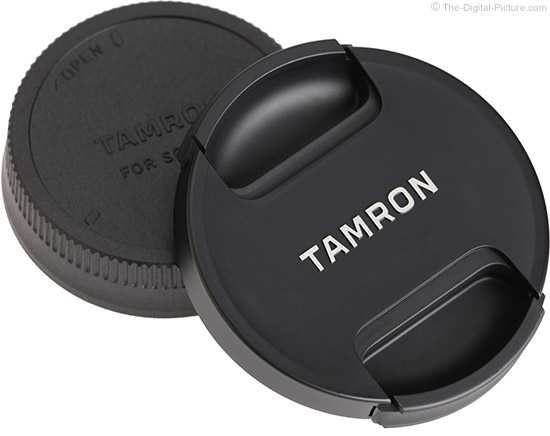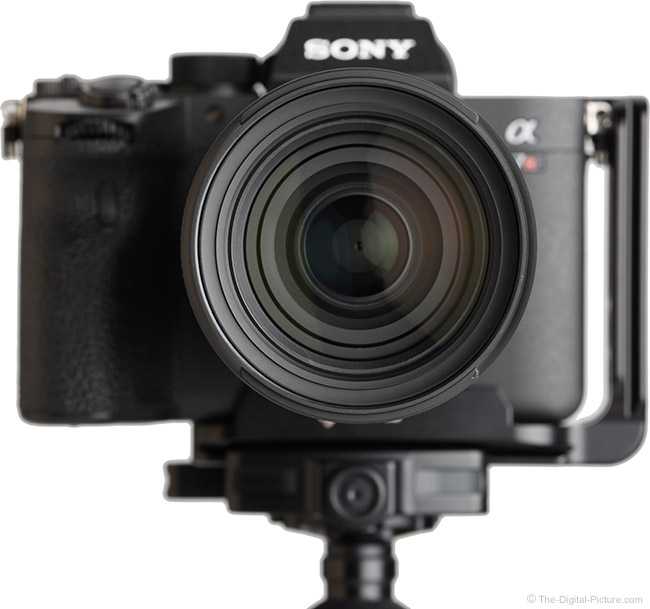Тема: Объективы Tamron, Объектив
Ресурс: Club Nikon
Форум: Оптика для фотокамер Nikon
Автор реплики: bob
У меня очень недолгое время был такой Тамрон, он мне достался случайно можно сказать. Просто я купил Д70 в комплекте с ним.
Потом объектив продал, т.к. гиперзум мне в принципе не нужен. Из недолгого использования могу сказать следующее:
Основные достоинства:
— приличный конструктив, т.е. хороший пластик, приятная резина на накатках, ничего не люфтит, даже если вывернуть объектив на 200 мм, пластиковый байонет особым недостатком не считаю.
— есть зум лок, т.е. замок в положении зума 18 мм для того, чтобы хобот не выезжал, когда объектив на камере.
Основные недостатки:
— медленный автофокус, он действительно медленный, видимо отверткой провернуть такое количество линз трудно.
— сильная дисторсия на широком угле.
Если Вам нужен именно гиперзум, то снимать им можно, но с приведенными оговорками.
Автор реплики: RaJa
Этот объектив я выбрал для себя в качестве штатного. Представляет из себя бочонок с диаметром под светофильтр 62 мм.
При выборе сравнивал с 18-55 китовым Nikkor, а также Sigma 18-200 3.5-6.3. Могу сказать, что объектив сделан качественно, имеет скругленные лепестки диафрагмы, благодаря чему более ровно и корректно рисует ночью огоньки фонарей.
Довольно неплох по всему диапазону ФР, достаточно легок. Имеет незначительне ХА, которые можно выявить, если постараться, но при моем достаточно критическом отношении они незаметны на большинстве снимков.
Понравился по ощущениям более качественной картинкой по сравнению с Сигмой, более точной фокусировкой, практически отсутствуют люфты как в сложенном так и в полностью выдвинутом состоянии.
Зуммируется линейно, плотный ход кольца
Из недостатков — шумная фокусировка, вращение кольца фокусировки при автофокусе, что заставляет в перчатках осторожно хвататься за него, дабы не зажать кольцо пальцем, мешая ему фокусироваться. В принципе, мне нравится его рисунок, им даже можно снимать портреты, но размытие фона конечно будет не таким как на портретниках, все таки в портретных ФР у него светосила невелика
Да, как и все гипрезумы зуммируется силой притяжения, то есть выдвигать наклонив трубу вниз ощутимо легче, как и складывать повернув трубой в небо, потому замок зума в положении 18 мм в принципе полезен.
Пока до конца не выявил все его особенности, но в целом линзой доволен.
Следующей линзой возможно будет 70-300 4-5.6 от Тамрона или Nikkor или 28-75/2.8 XR, если денег не жалко будет.
Кстати, у меня Tamron фокусируется достаточно быстро ввиду включенной функции подсветки автофокуса на D70s.
То есть пробегается весь диапазон небыстро, потому как линз много и таскать их далеко, вввиду чего не стоит терять объект из зоны фокуса или нежелательно использовать автофокус без учета информации из других зон фокусировки (Single Zone), но если поймал один раз объект или его соседа в близком диапазоне — фокусировка в следящем режиме работает отменно, что позволяет вести машины и объекты крупнее птички в 1/10 площади кадра уверенно и точно.
Отсюда — если объект мелкий, можно потерять его из поля зрения, тут приходит на помощь ФР до 200, но и она не всегда достаточна, а вот если удержали его в кадре — остальные точки фокусировки не дают линзе бежать шарить по всему диапазону, а подсказывают в каком направлении побежал объект и дофокусировка происходит коротким перемещением линз, что происходит очень оперативно, проверено.
Неудобств от фокусировки не испытываю практически. Звук отвертки позволяет точно знать, фокусируется он или нет уже готов, когда следишь за объектом при режиме AF-C. Повторюсь — если объектив сфокусирован на 1м, а мы срочно пытаемся сфотографировать что-то на бесконечности — можно крутануть рукой в М, потому как нервным может доставить неудовольствие секунду ждать пробега по всему диапазону.
Если же мы ищем что-то на дистанции метров 5, то разницу в 4 метра пробегает уверенно и почти мгновенно. почти никогда не делает как Sigma — бегает туда -сюда в поисках цели, такое можно спровоцировать закрыв линзу крышкой или выбрав боковую зону фокусировки и наводясь по вертикальной линии.
Alternatives to the Tamron 28-200mm f/2.8-5.6 Di III RXD Lens
Logical for Sony camera owners is to also consider the Sony FE 24-240mm f/3.5-6.3 OSS Lens.
Immediately apparent is that the Sony lens has a focal length range advantage over the Tamron lens.
In the image quality comparison at wide-open apertures, the Tamron lens shows a slight sharpness advantage
and often a 2/3-stop aperture opening advantage.
At the long end, 200mm vs. 240mm, the Tamron holds a strong sharpness advantage that holds through f/11.
The sharpness differences become lesser at the wide end at f/8.
The Tamron lens shows less peripheral shading at the focal length extents and slightly more in the mid-range.
Equivalent wide apertures increase the Tamron advantages.
At the wide end, the Sony lens has considerably stronger barrel distortion.
The Tamron has slightly stronger pincushion distortion in the mid-range and somewhat less at the long end.
Regarding specs and measurements, the Tamron 28-200mm f/2.8-5.6 Di III RXD Lens vs. Sony FE 24-240mm f/3.5-6.3 OSS Lens comparison shows the Tamron lens lighter and slightly thinner.
The thinner aspect leads to a smaller filter thread diameter, 67mm vs. 72mm.
The Tamron lens has a higher maximum magnification (0.32x vs. 0.27x).
The Sony lens has Optical SteadyShot coordinating with IBIS vs. IBIS only.
Your checking account likes the Tamron lens, at roughly 70% of the Sony price, best.
While the Canon RF 24-240mm F4-6.3 IS USM Lens requires a different camera brand to use, it is still interesting to make the comparison.
Again, the Tamron lens has a shorter focal length range and a wider max aperture.
In the image quality comparison, discernment in test camera resolution is required until the Canon lens is tested on a higher resolution body.
That said, with a wide-open aperture, the Tamron has a very slight advantage at the wide end, and the Canon wins at 50mm.
I like the Tamron lens center and the Canon lens periphery at 100mm.
The Tamron lens performs best in the 200mm vs. 240mm comparison.
Stopping down to f/8 reduces the differences, but they remain.
The Tamron lens shows less peripheral shading at the long end, less at equivalent wide apertures, and less when stopped down at the long end.
The Canon lens shows less geometric distortion and more flare effects in our tests.
Regarding specs and measurements, the Tamron 28-200mm f/2.8-5.6 Di III RXD Lens vs. Canon RF 24-240mm F4-6.3 IS USM Lens comparison shows the Tamron lens slightly thinner and modestly lighter.
The narrower aspect leads to a smaller filter thread diameter, 67mm vs. 72mm.
The Tamron lens has a higher maximum magnification (0.32x vs. 0.26x).
The Canon lens has image stabilization coordinating with IBIS vs. IBIS only.
The Tamron lens has a modestly lower price.
Use the site’s comparison tools to create additional comparisons.
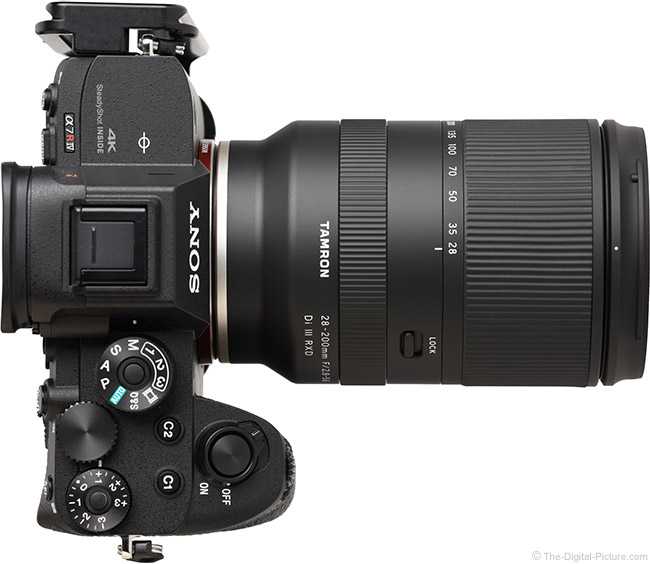
Summary
With the Di III lens lineup, Tamron has been impressing, repeatedly delivering lenses with excellent image quality, wide aperture openings, light weight, compact size, quality AF systems, classy designs, and low prices being especially notable.
Some of these lenses, including this one, shorten the industry-standard focal length ranges.
Still, these lenses minimally match, or in this case, exceed the widest aperture openings in comparable lenses.
The Tamron 28-200mm f/2.8-5.6 Di III RXD Lens aligns with expectations from the DI III moniker.
A super-zoom lens holds substantial advantages, but image quality, at least over a subset of the focal length range, is often sacrificed.
While other zoom lenses may optically perform better within their focal length ranges, the Tamron 28-200mm f/2.8-5.6 Di III RXD Lens equates to the full range of two them, and this lens is a strong performer overall with, relatively speaking, impressive image quality.
This lens is not perfect, creating some colorful aberrations and showing some misfocusing, but it is a solid performer in its class.
Again, the Tamron 28-200mm f/2.8-5.6 Di III RXD is a light, compact lens that delivers class-leading image quality and bears an affordable price.
It is an excellent choice for those looking for a travel lens or merely wanting a fun, burdenless lens to take everywhere with them.
Bringing you this site is my full-time job (typically 60-80 hours per week). Thus, I depend solely on the commissions received from you using the links on this site to make any purchase. I am grateful for your support! — Bryan
My Recommended Tamron 28-200mm f/2.8-5.6 Di III RXD Lens Retailers
Rent the Tamron 28-200mm f/2.8-5.6 Di III RXD Lens
The Tip Jar
Tamron 28-200mm f/2.8-5.6 Di III RXD Lens
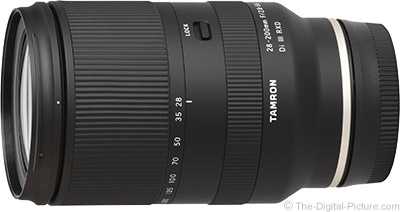
- Specifications
- Press Release
by Bryan Carnathan$80.00 Savings!
Manufacturer ID:A081Review Date: 2021-01-14
Navigate the Reviews« Tamron 28-75mm f/2.8 Di III VXD G2 Lens Review» Tamron 35-150mm f/2-2.8 Di III VXD Lens Review
Canon & Sony News, Deals, Blog
- Bull Elk Hiding in a Pine Tree, Rocky Mountain National Park
… More Canon & Sony News
Image Quality
Under low light (which is common with strobes), the AF had no issues acquiring my daughter’s eyes.
I mentioned at the beginning of this review that I had some preconceived biases with my experience of superzooms. This is one of those occasions where I was happy to be proved wrong.
I expected the 28-200mm to be good, but it is really an outstanding lens. I know that may seem like a fairly open statement, so let me clarify.
I think the Tamron 28-200mm f/2.8-5.6 Di III RXD is close enough to the Tamron 28-75mm f/2.8 Di III RXD that a large portion of the user base who don’t need the f/2.8 across the entire focal length would be happy with the lens. Given how close the 28-75 is to the Sony 24-70mm GM, that’s impressive.
As far as distortion goes, there is nothing to be concerned about. The limited distortion is easily fixed in Lightroom or Capture One, and the standard lens profiles should take care of this.
The Tamron 28-200mm f/2.8-5.6 Di III RXD had no problems keeping up with birds, even when they were quick.
Chromatic aberration is well controlled. Given the focal range, that’s an impressive feat. It’s not completely absent, but you have to push the lens to see it, mainly around trees directly into sunlight or reflections off the water.
Over the time period I was reviewing this lens, I found myself adding the 28-200mm to my shopping cart only to stop myself at check out. What are you doing, you idiot, you’re a prime shooter!
And yet a week later, it would find its way back into my cart while I thought about how nice it would be to have in my quiver of lenses. I’m heading away on holiday soon, and I know this on lens would help me drop three lenses out of my kit…
Tamron 28-200mm f/2.8-5.6 Review | Conclusion
As is the case with many of the lenses Tamron has produced for Sony, I think they’re onto another winner.
These kinds of lenses are the exact reason Tamron is hitting it out of the park at the moment.
It’s a lens that has knocked the Sony FE 24-105mm f/4 G OSS off the mantle as the best travel lens. While the 24-105mm offers the wider 24mm and OSS, it loses the 105-200mm range.
The Tamron 28-200mm f/2.8-5.6 Di III RXD has no issues matching the image quality of the Sony 24-105mm, and while it loses the f/4 at the longer end, it also offers f/2.8 on the wider end, and it does so at half the cost.
As for whether I ended up purchasing one, I decline to say anything on the basis that I may incriminate myself. I’m a prime shooter, so there is no reason for me to have a superzoom in my bag, even if it is just for travel.
One of my young daughters must have accidentally ordered it when I left my laptop open…
Highly Recommended Tamron 28-200mm f/2.8-5.6
Innovative, lightweight all-in-one zoom lens that shines in a variety of situations – from macro to landscape.
Check Current Price
An All-in-One for Shutterbugs
Superzoom lenses have a bad rap with photo enthusiasts, and not without reason. Even the better examples cut corners, and are mostly made for consumer-grade APS-C cameras rather than the full-frame sensor cameras that enthusiasts and pros buy.
Sony a7R IV, 119mm, f/5.6, 1/200-second, ISO 100 (Credit: Jim Fisher)
The Tamron 28-200mm F2.8-5.6 Di III RXD is sure to change some attitudes. It’s compatible with full-frame models, and delivers crisper images with less distortion than you’d expect from an all-in-one zoom. It’s built well, too—materials are sturdy and incorporate dust and splash protection.
It’s sensibly sized for travel, and priced competitively—a few hundred dollars less than Sony’s similar FE 24-240mm F3.5-5.6 OSS ($1,049.99). While we would have loved to see Tamron deliver a lens that starts at 24 or 25mm instead of 28mm, it’s not enough to deter us from recommending the 28-200mm F2.8-5.6 as our Editor’s Choice.
(Credit: Jim Fisher)
It’s the best lens of this type we’ve seen for any full-frame system, and it’s a shame that Tamron is only offering it in E-mount at this point. Canon R, Nikon Z, and Panasonic L-mount system owners have a bit of reason to be jealous of this one.
Tamron 28-200mm F2.8-5.6 Di III RXD
4.0
Editors’ Choice
See It
$729.00 at Amazon
MSRP $729.00
Pros
- Long zoom for wide angle and telephoto imaging
- Works with full-frame and APS-C sensor models
- All-weather construction with fluorine coating
- 1:3 macro focus
- Sized well for travel
View More
Cons
- Only available for Sony systems
- Reliant on in-camera stabilization
- Uncorrected Raw shots exhibit distortion and vignette
The Bottom Line
The Tamron 28-200mm F2.8-5.6 Di III RXD is a full-frame zoom lens with a big 7.1x ratio. Its quality build and optics offer plenty of appeal for enthusiasts and pros looking for a one-lens solution.
Like What You’re Reading?
Sign up for Lab Report to get the latest reviews and top product advice delivered right to your inbox.
This newsletter may contain advertising, deals, or affiliate links. Subscribing to a newsletter indicates your consent to our Terms of Use and Privacy Policy. You may unsubscribe from the newsletters at any time.
Thanks for signing up!
Your subscription has been confirmed. Keep an eye on your inbox!
Sign up for other newsletters
3.1 with Sony 24-240 F3.5-6.3
Overall the Tamron 28-200mm is way above the Sony FE 24-240mm F3.5-F6.3, much better shaprness in the centre , better AF , better background blur, lower CA, lower distorsion, less expensive
Globalement le Tamron 28-200mm est nettement meilleur que le Sony FE 24-240mm F3.5-F6.3, meilleur piqué au centre, meilleur AF, meilleur flou d’arrière plan, moins d’aberrations chromatiques, plus faible distorsion, moins cher !
Specifications
Sony FE 24-240mm F3.5-F6.3 vs Tamron 28-200
- Weight / Poids : 780 gr vs 623g
- Price / Prix: 1100 euros vs 870 euros
- Length/ Longeur : 118,5mm vs 118mm
- Filter / Filtre : 72mm vs 67mm
- Optical stabilisation vs None / Stab optique pour Sony
- 7 blades aperture = same / 7 lamelles de diaphragme pour les deux
- Minimal focusing distance / distance min de mise au point: 50-80 cm vs 19-80cm
- Dust and moisture resistant for both / Protection tout temps pour les deu
| Aperture / ouverture | Tamron 28-200mm | Sony 24-240mm |
| F2.8 | 28mm | |
| F3.2 | 32mm | |
| F3.5 | 44mm | 24mm |
| F4 | 56mm | 28mm |
| F4.5 | 79mm | 40mm |
| F5 | 117mm | 55mm |
| F5.6 | 158mm | 72mm |
Better aperture for the Tamron / Meilleure ouverture pour le Tamron
Winner / Gagnant = Tamron

Autofocus
- Sony : The Autofocus has an average performance. Don’t expect to take sports actions photos or kids running all around with this lens. Lens is also sometimes hunting at close distance
- Tamron : The AF is fast and efficient (90% accuracy) , including for sports action. The AF has more difficulty in lowlight at 200mm due to the F5.6 max aperture
- Sony : L’autofocus est moyen, n’espérez pas prendre de la photo d’action ou des enfants qui courent. L’objectif pompe également de temps en temps
- Tamron : l’autofocus est rapide et efficace (90% de précision), y inclus pour de la photo d’action. l’AF est plus hésitant en basse lumière à 200mm à cause de la faible ouverture de F5.6
Winner / Gagnant = Tamron

Tamron : AF tracking
Sharpness / Piqué

- The Sony is at best average
- The Tamron reach excellent level in the centre and good level in the corners
- Le Sony est au mieux moyen
- Le Tamron atteint le grade excellent au centre et bon dans les coins
Winner / Gagnant = Tamron

FE 24-240mm F3.5-6.3 OSS at 240 mm – ¹⁄₅₀₀ s à ƒ – 6,3 à ISO 100-034-2
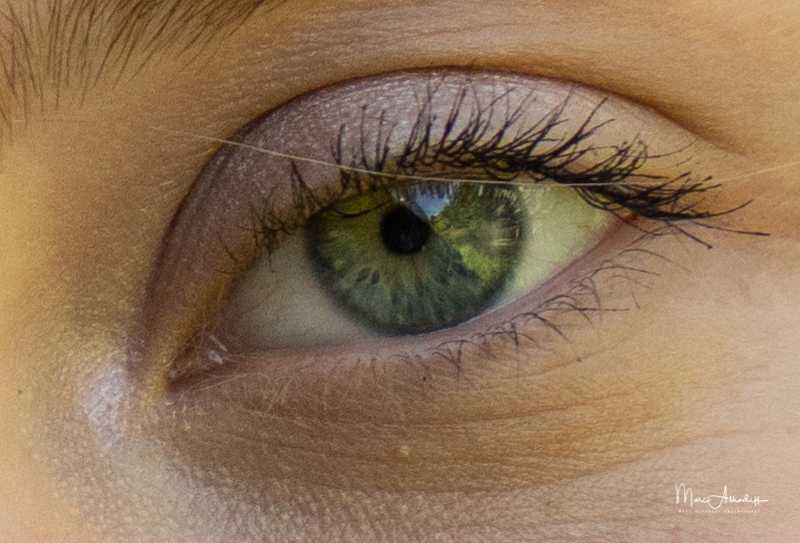
Tamron Crop 100% 200mm
CA and distorsion / AC et distorsion
- The Sony exhibits big CA and big distorsion
- The Tamron has very low CA and moderate distorsion
- Le sony souffre d’AC importantes et de forte distorsion
- Le Tamron a de faible AC et une distorsion moyenne
Winner / Gagnant = Tamron

Sony CA
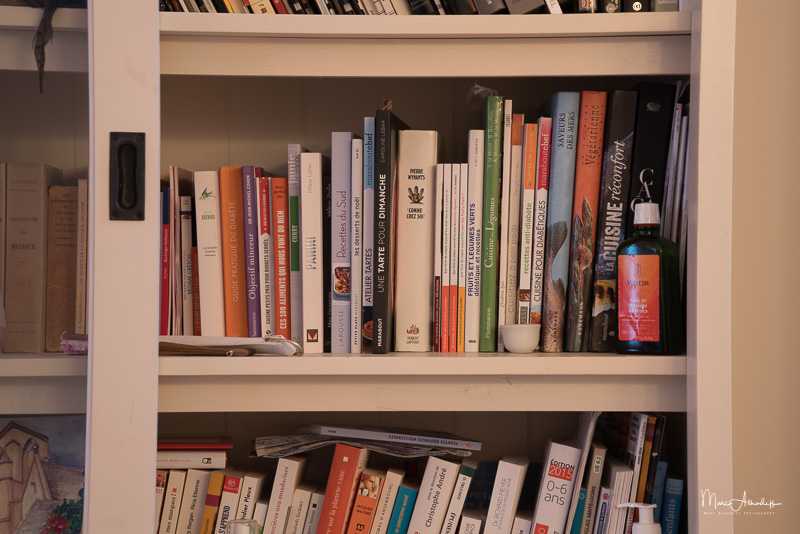
Sony distorsion 100mm

Tamron 100mm
Bokeh / color rendition – Bokeh / rendu des couleurs
- Sony : Background blur and color rendition are good but not more , Bokeh balls are heptagon
- Tamron : Background blur is very good and soft , color rendition is also very good. Bokeh balls are heptagon
- Sony: le flou d’arrière plan et le rendu des couleurs est bon sans plus. Les ronds de Bokeh sont des heptagones
- Tamron : le flou d’arrière plan est doux et très plaisant, le rendu des couleurs est aussi très bon. Les ronds de Bokeh sont des heptagones
Winner / Gagnant = Tamron

Sony

Tamron

Sony

Tamron
Focal Length Range
At the top of the lens selection funnel is the focal length range needed for the task at hand.
With 28-200mm availed, this lens offers a broad funnel.
The right focal length provides the ideal working distance and perspective for the composition to be captured.
This lens’s substantial focal length range, covering a range otherwise requiring at least two zoom lenses, suits a broad range of needs, providing ideal perspectives in a large percentage of encountered scenarios.
It seems easier to list what uses these focal lengths are not optimal for vs. listing the ideally uses for this range.
With the ultra-wide-angles missing, interior architecture and some landscape uses may require a panorama technique at 28mm.
Or, get the Tamron 17-28mm f/2.8 Di III RXD Lens, a focal length efficient complement to this range.
This 28-200mm lens will likely be found short for large field sports with significant cropping needed from 200mm captures.
This focal length range on a full-frame camera is only marginally useful for wildlife photography, optimally, environmental wildlife portraits, or for large or close animals.
Your pets likely qualify.
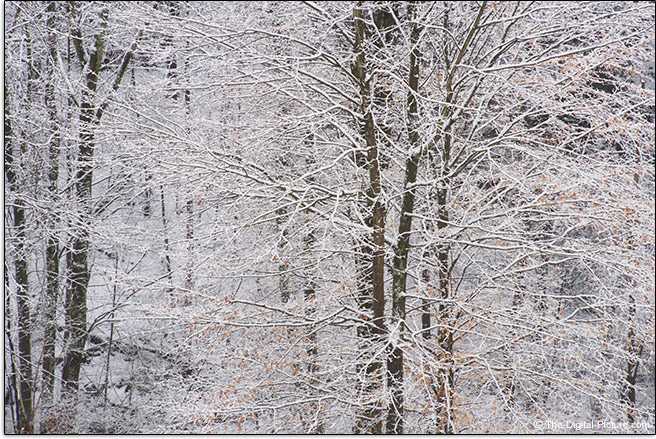
This lens has great utility for landscape photography.
The 28-200mm focal length range is especially suited for family and travel needs, and there are a host of video uses for this range.
Here is an example of what this focal length range looks like:
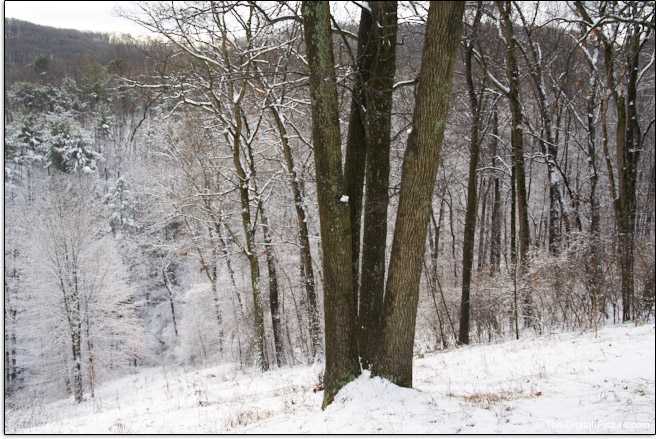
28mm |
50mm |
70mm |
100mm |
135mm |
200mm
APS-C sensor format cameras utilize a smaller portion of the image circle.
That means a scene is framed tighter, with 1.5x being the full-frame angle of view equivalence multiplier for Sony’s lineup.
With an angle of view similar to a 42-300mm lens on a full-frame camera, this lens on an APS-C camera has much-improved telephoto capabilities, ideal for some sports and wildlife uses.
That combination eliminates the wide angles.
A question that often arises regarding lenses with exceptional focal length ranges is, «How accurate are the specified focal lengths?»
At 28mm, our recorded distance to the test chart for this lens is in the mix with the measurements from 28mm prime lenses we’ve tested.
At 200mm, we recorded a focus distance of 22.22′ (6.773m), just slightly shorter than the Nikon 200mm f/2G AF-S VR II Lens’s 22.62′ (6.896m) measurement and
modestly shorter than the Canon EF 200mm f/2L IS USM Lens’s 23.44′ (7.144m) distance.
Lens focal lengths are rated at infinity focus distance, and geometric distortion can affect our chart framing.
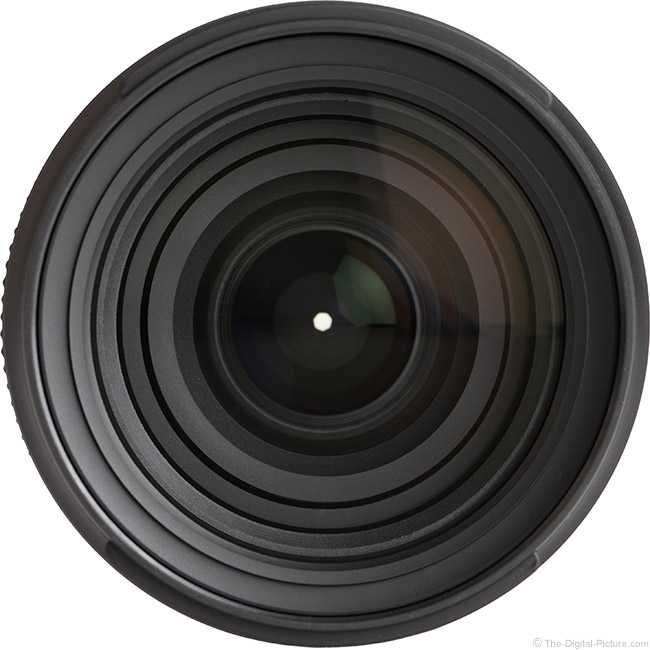
Build & Ergonomics
The Tamron 28-200mm f/2.8-5.6 Di III RXD is mid-sized, but small enough to carry around for travel without looking like a target for thieves.
The construction on the Tamron 28-200mm is fairly similar to the rest of Tamron’s range of RXD lenses. It’s a high-quality modern plastic construction.
The zoom and manual focus mechanisms are smooth. My only dislike on the build quality is the hood, which feels like a lower-grade plastic than the rest of the lens, but it’s not a deal-breaker in my opinion.
As far as features go, this portion is going to be a little bare. Unlike Sigma and Sony, Tamron has kept buttons and switches to a minimum.
I consider that an acceptable compromise for the target market of this lens. Sony cameras provide enough button customisation to avoid this being an issue.
Alongside the Tamron 70-300mm f/4.5-6.3 Di III RXD, the Tamron 28-200mm f/2.8-5.6 Di III RXD is compact.
This isn’t the kind of lens where I would typically switch between manual and autofocus on the fly. The only switch you’ll find is a lens lock which keeps the lens locked in a compact form.
Aside from that, you’ll find the zoom ring and manual focus ring. Both of these are good quality with a nice feel.
The one thing missing from this lens is lens stabilisation. This could be a showstopper for owners of older generation Sony A7 cameras, but for the newer models, it’s a minor inconvenience at best.
While the newer bodies have IBIS, I still think the focal range warrants IBIS. Lenses with stabilisation offer about 1 – 1.5 stops improvement over their non-stabilised counterparts. I would consider that when you are taking photos at longer focal lengths.
Build Quality & Features
As with the other Di III lenses, the light weight and polycarbonate exterior design are not reminisce of a rugged design, but still, this lens feels like a high-quality product, and Tamron USA’s 6-year warranty backs that premise.
The tight tolerances on moving parts, including negligible play on the extended inner barrel, add some assurance that this lens has been carefully designed and that modern construction methods were utilized.
The lens has a very nicely-smooth narrow shape, and the matte/satin black finish, along with the engraved white lettering with a modern, attractive font style, looks classy.
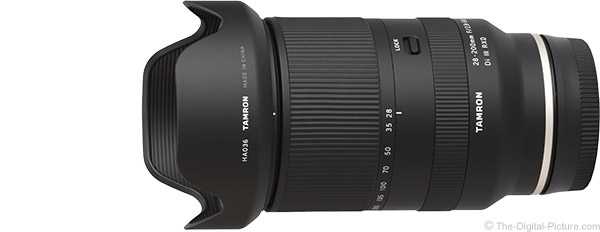
MFD |
∞
MFD |
∞
w/ Hood: MFD |
∞
MFD |
∞
Rotated
Compare »
The nicely-sized, rubber-coated zoom ring rises very slightly from the barrel and is very smooth with no play.
As I said before, I generally prefer the zoom ring to be located behind the focus ring, but this design works fine.
The lens extends with zooming by 2.17″ (55mm) at 200mm.
This lens has no buttons and one switch, a lock switch that holds the lens in the retracted state, though gravity zooming was not an issue on the reviewed lens.
The AF/MF button is one that I do miss, and having to navigate a menu option (programmed to a custom button) for this commonly-used feature is inefficient.
Those who do not use MF will find the lack of this switch an advantage, and the lack of switches should mean increased reliability and decreased the chance for dirt and moisture penetration.
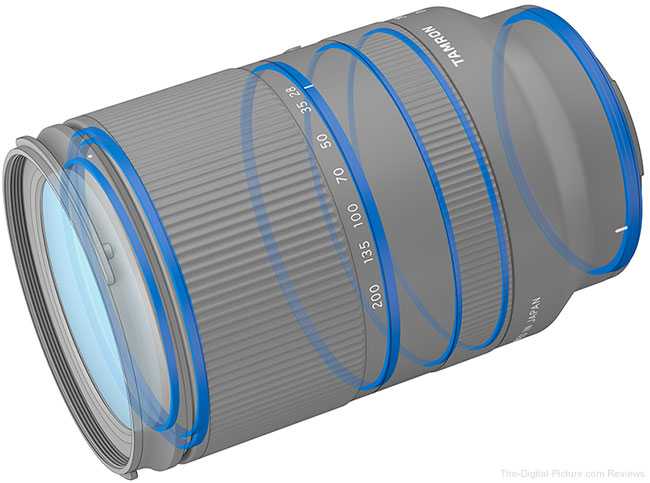
«Seals are located at the lens mount area and other critical locations to deter infiltration of moisture and/or rain drops and afford Moisture-Resistant Construction.»
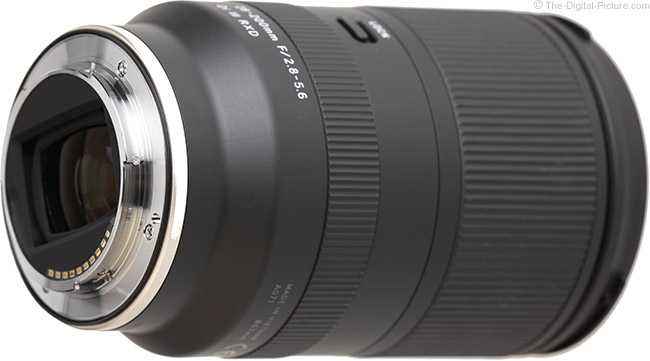
«Also, the front surface of the lens element is coated with a protective fluorine compound that has excellent water- and oil-repellant qualities.
The lens surface is easier to wipe clean and is less vulnerable to the damaging effects of dirt, moisture or oily fingerprints, allowing for much easier maintenance.»
The Tamron lens gives up some of the focal length range of the two comparison lenses I selected below, but it also gives up some of their weight (and gains aperture diameter).
| Model | Weight oz(g) | Dimensions w/o Hood «(mm) | Filter | Year | ||
| Canon RF 24-240mm F4-6.3 IS USM Lens | 26.5 | (750) | 3.2 x 4.8 | (80.4 x 122.5) | 72 | 2019 |
| Sony FE 24-240mm f/3.5-6.3 OSS Lens | 27.5 | (780) | 3.2 x 4.7 | (80.5 x 118.5) | 72 | 2015 |
| Tamron 28-200mm f/2.8-5.6 Di III RXD Lens | 20.3 | (575) | 2.9 x 4.6 | (74.0 x 117.0) | 67 | 2020 |
For many more comparisons, review the complete Tamron 28-200mm f/2.8-5.6 Di III RXD Lens Specifications using the site’s lens specifications tool.
As with most other Sony E-mount lenses, my knuckles uncomfortably press against the barrel of this lens when using the Sony a7R III and IV, though the rounded shape at the point of impact is helpful in that regard.
Here is a visual comparison:
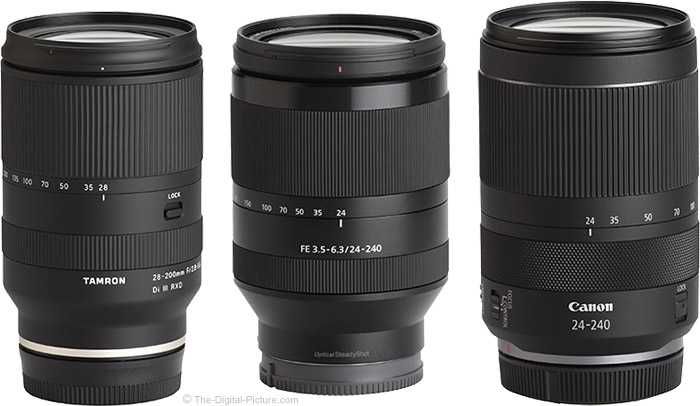
Positioned above from left to right are the following lenses:
Tamron 28-200mm f/2.8-5.6 Di III RXD LensSony FE 24-240mm f/3.5-6.3 OSS Lens
Canon RF 24-240mm F4-6.3 IS USM Lens
The same lenses are shown below with their hoods in place.
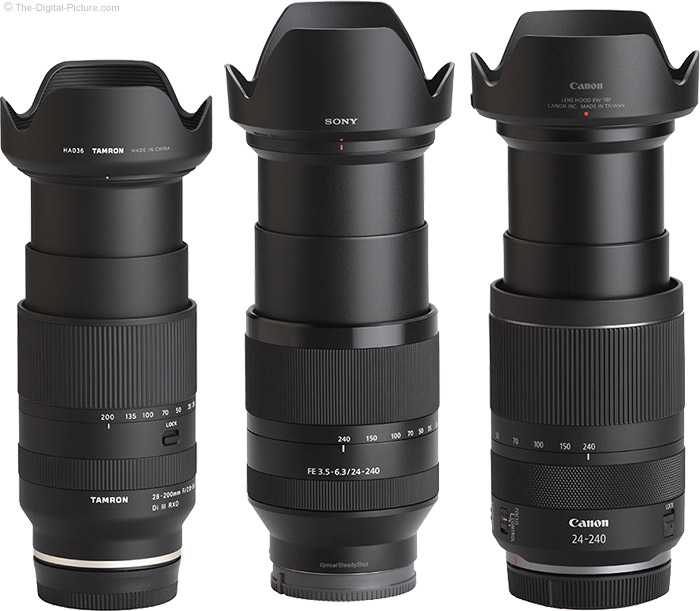
Use the site’s product image comparison tool to visually compare the Tamron 28-200mm f/2.8-5.6 Di III RXD Lens to other lenses.
I loaded that link with another comparison.
If you are following Tamron’s Di III lens lineup, you knew the filter size for this lens would be 67mm.
This size is relatively common overall, and within Tamron’s Di III lineup, expected.
Traveling with a kit of Di III lenses?
You likely need to pack on 67mm effects filters (such as circular polarizer and neutral density filters).
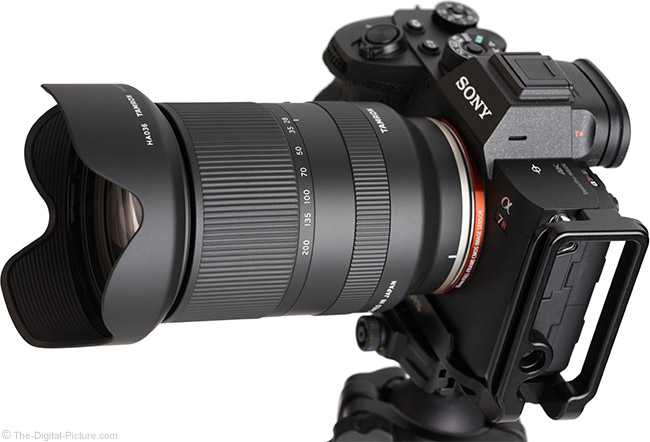
The Tamron HA036 lens hood is included in the box.
This semi-rigid plastic petal-shaped hood has a ribbed interior designed to avoid reflections.
This hood offers some physical protection and, at the widest focal lengths, optimal protection from bright light.
An advantage of this hood shape is easier installation alignment (simply learn the small petal to the top orientation), while a rounded hood enables the lens to stand on its hood.
A push-button release is not provided, but this hood rotates smoothly and reassuringly clicks into place.
